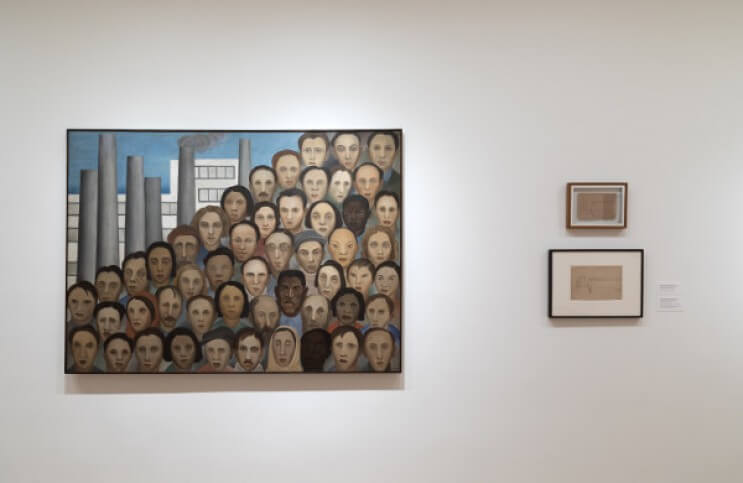
How Tarsila do Amaral Invented Modern Art in Brazil
Two weeks ago, the exhibition Tarsila do Amaral: Inventing Modern Art in Brazil opened at the Museum of Modern Art (MoMA), New York. Known colloquially in Brazil as just Tarsila, this influential artist is considered the first to develop a distinctly modern Brazilian aesthetic position. She was one of the so-called Grupo dos Cinco, or Group of Five, a collective of Brazilian artists formed in the 1920s with the goal of developing Brazilian Modernism. The other four artists in the Grupo dos Cinco were Anita Malfatti, Menotti Del Picchia, Mário de Andrade, and Oswald de Andrade. Tarsila became the first to achieve the goal of the group in 1928, when she finished her landmark painting, Abaporu. The painting shows an elongated, monstrous figure with a tiny head seated beside a gigantic cactus, on which an enormous flower grows. The flower has the characteristics of the sun. This massively significant painting is one of more than 100 works by Tarsila on view in the MoMA exhibition, the first monographic show of her work in the United States. What makes this painting so important is its symbolism, which is communicated in the title. Abaporu means cannibal. The visual language of the painting is inspired by Surrealism, but the content is unmistakably Brazilian. It was intended to show the cannibalism of one culture by another culture. It was a call for Brazil to devour Europe, before Europe completely devours Brazil. Not only did this painting give birth to a new style of art—it was also considered a call to arms to all Brazilians to digest the influences of the rest of the world, to translate them, and to make them their own in order to discover what the future of Brazil could be.
The Undated World
The land now known as Brazil has been inhabited for more than 10,000 years, at least. The oldest pottery in the Western Hemisphere was found in Brazil, along the Amazon River—it dates back 8,000 years. Stone megaliths that date back about 2,000 years have been found in Amapá, a region of northern Brazil. The ancient, indigenous Brazilian people developed complex languages, distinctive customs, advanced political traditions and religious beliefs. They were adept builders and philosophical thinkers. They were not waiting to be discovered—they were the writers of their own culture and history. Their population was more than seven million strong, spread across thousands of tribes, when the Portuguese first landed in the year 1500. In just a few decades, those Portuguese colonists completely transformed that ancient culture, subjugating entire populations, replacing ancient languages and religions, imposing new artistic styles, and transplanting existing morals with those of Europe.

Tarsila do Amaral: Inventing Modern Art in Brazil, Museum of Modern Art, New York, 2018, installation view
By the time Tarsila was born, Brazil was in danger of becoming a shadow of its original self. Tarsila herself was a member of the capitalist elite. Her family grew and exported coffee, which enabled her to travel extensively in Europe as a child. She copied European art, and as an adult attended a private art school in Paris called the Académie Julian. Two years into her Parisian education, Tarsila returned to São Paulo, and saw her home through different eyes. She began to realize that there was much about Brazil that still had not been altered by European colonialism. When she returned to Paris, this time to study with Cubists painters like Albert Gleizes and Fernand Léger, she brought with her the colors, forms and subjects of her native country. It was the perfect time for it. European artists were frantically copying the indigenous art styles of the countries they had colonized. As Tarsila wrote to her family in a letter from Paris in 1923, “Paris has had enough of Parisian art.”

Tarsila do Amaral: Inventing Modern Art in Brazil, Museum of Modern Art, New York, 2018, installation view
The Painter of Her Country
Tarsila declared, “I want to be the painter of my country.” Back in Brazil, she began a relationship with the poet Oswald de Andrade, who shared her passionate desire to create a Modernist Brazilian culture. It was for Oswald that Tarsila painted Abaporu. In turn, Oswald wrote the Anthropophagite Manifesto based on the painting. Anthropophagy is another word for cannibalism. Many indigenous Amazonian tribes cannibalized their enemies in times of war. The Anthropophagite Manifesto stated, “Before the Portuguese discovered Brazil, Brazil had discovered happiness.” It proposed that the devouring of other cultures is the ancient law of human progress, and pointed out that Europe built its modern culture by devouring the ancient cultures of its conquered lands. Oswald called for “Absorption of the sacred enemy,” and dated his manifesto “Year 374 of the swallowing of the Bishop Sardinha,” referring to the year that Sardinha, the first Catholic Bishop of Brazil, became shipwrecked and was captured by the indigenous Caeté tribe, who practiced Anthropophagy. Spoiler alert: they ate him.

Tarsila do Amaral - Abaporu, 1928, Oil on canvas, 33 7/16 × 28 3/4" (85 × 73 cm), Collection MALBA, Museo de Arte Latinoamericano de Buenos Aires
In 1929, Tarsila showed off her new paintings, with their exhilarating vision of Brazilian Modernism, in two solo exhibitions in Brazil—one in Rio de Janeiro, and one in São Paulo. After that, she exhibited the works in group shows in the United States, Europe, and Russia. While touring, she ended her relationship with Oswald. While in Russia she became so moved by the poverty and suffering of the Russian people that when she returned to Brazil, she was reinvigorated to pursue social justice, while continuing to foster the growth of Brazilian Modernism. Over time, her style matured more, always drawing inspiration and content from what Tarsila considered to be distinctly Brazilian subject matter—things like birds, sunlight, flowers, and the Brazilian people. Her celebration of what was always original to Brazilian culture influenced future generations of Brazilian artists, whom she helped empower to confidently assert that their history is distinct from that of Europe. Simultaneously, her deft cultural cannibalism has inspired artists hailing from colonized cultures all over the world to free themselves to devour the influences of their oppressors.
Featured image: Tarsila do Amaral: Inventing Modern Art in Brazil, Museum of Modern Art, New York, 2018, installation view
All images courtesy of MoMA
By Phillip Barcio






